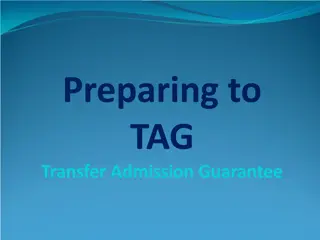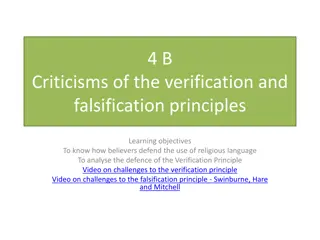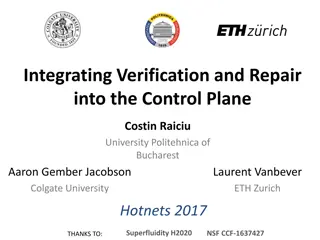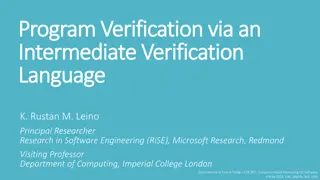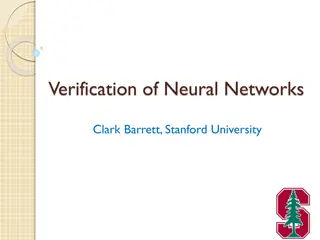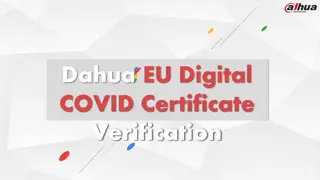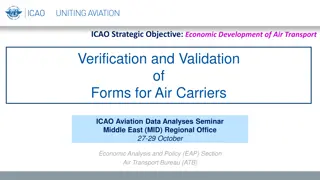Data Model Analysis and Verification at University of California Santa Barbara
Joint work on data model analysis and verification conducted by Tevfik Bultan, Jaideep Nijjar, and Ivan Bocic at the University of California, Santa Barbara. Acknowledgement of NSF support with insights into web application dependability and notable quotes from President Obama about coding.
Uploaded on Feb 19, 2025 | 1 Views
Download Presentation

Please find below an Image/Link to download the presentation.
The content on the website is provided AS IS for your information and personal use only. It may not be sold, licensed, or shared on other websites without obtaining consent from the author.If you encounter any issues during the download, it is possible that the publisher has removed the file from their server.
You are allowed to download the files provided on this website for personal or commercial use, subject to the condition that they are used lawfully. All files are the property of their respective owners.
The content on the website is provided AS IS for your information and personal use only. It may not be sold, licensed, or shared on other websites without obtaining consent from the author.
E N D
Presentation Transcript
Data Model Analysis and Verification Tevfik Bultan University of California Santa Barbara Joint work with 1 Jaideep Nijjar and Ivan Bocic
Acknowledgement: NSF Support HTTP Status 500 - type Exception report message description The server encountered an internal error () that prevented it from fulfilling this request. exception javax.servlet.ServletException: flp.fl_appl_stts not found. Specify owner.objectname or use sp_help to check whether the object exists (sp_help may produce lots of output). org.apache.jasper.runtime.PageContextImpl.doHandlePageException(PageContextImpl.java:830) org.apache.jasper.runtime.PageContextImpl.handlePageException(PageContextImpl.java:763) org.apache.jsp.fastlane_jsp._jspService(fastlane_jsp.java:242) org.apache.jasper.runtime.HttpJspBase.service(HttpJspBase.java:105) javax.servlet.http.HttpServlet.service(HttpServlet.java:860) org.apache.jasper.servlet.JspServletWrapper.service(JspServletWrapper.java:336) org.apache.jasper.servlet.JspServlet.serviceJspFile(JspServlet.java:302) org.apache.jasper.servlet.JspServlet.service(JspServlet.java:251) javax.servlet.http.HttpServlet.service(HttpServlet.java:860) org.apache.jasper.runtime.PageContextImpl.doForward(PageContextImpl.java:675) org.apache.jasper.runtime.PageContextImpl.forward(PageContextImpl.java:642) org.apache.jsp.index_jsp._jspService(index_jsp.java:44) org.apache.jasper.runtime.HttpJspBase.service(HttpJspBase.java:105) javax.servlet.http.HttpServlet.service(HttpServlet.java:860) org.apache.jasper.servlet.JspServletWrapper.service(JspServletWrapper.java:336) org.apache.jasper.servlet.JspServlet.serviceJspFile(JspServlet.java:302) org.apache.jasper.servlet.JspServlet.service(JspServlet.java:251) javax.servlet.http.HttpServlet.service(HttpServlet.java:860) root cause 2 java.sql.SQLException: flp.fl_appl_stts not found. Specify owner.objectname or use sp_help to check whether the object exists (sp_help may produce lots of output). gov.nsf.fastlane.util.ApplicationStatus.<init>(ApplicationStatus.java:95) org.apache.jsp.fastlane_jsp._jspService(fastlane_jsp.java:79) org.apache.jasper.runtime.HttpJspBase.service(HttpJspBase.java:105) javax.servlet.http.HttpServlet.service(HttpServlet.java:860) org.apache.jasper.servlet.JspServletWrapper.service(JspServletWrapper.java:336) org.apache.jasper.servlet.JspServlet.serviceJspFile(JspServlet.java:302) org.apache.jasper.servlet.JspServlet.service(JspServlet.java:251) javax.servlet.http.HttpServlet.service(HttpServlet.java:860) org.apache.jasper.runtime.PageContextImpl.doForward(PageContextImpl.java:675) org.apache.jasper.runtime.PageContextImpl.forward(PageContextImpl.java:642) org.apache.jsp.index_jsp._jspService(index_jsp.java:44) org.apache.jasper.runtime.HttpJspBase.service(HttpJspBase.java:105) javax.servlet.http.HttpServlet.service(HttpServlet.java:860) org.apache.jasper.servlet.JspServletWrapper.service(JspServletWrapper.java:336) org.apache.jasper.servlet.JspServlet.serviceJspFile(JspServlet.java:302) org.apache.jasper.servlet.JspServlet.service(JspServlet.java:251) javax.servlet.http.HttpServlet.service(HttpServlet.java:860) note The full stack trace of the root cause is available in the Sun-Java-System/Application-Server logs. Sun-Java-System/Application-Server
Web ApplicationDependability President Obama: I want to go in and fix myself, but I don't write code" 5
Web Application Dependability TRACKS: A todo list application http://getontracks.org/ Context Recurring Todo SCHOOL HOME WORK Feed the Dog EDIT 6
Web Application Dependability TRACKS Todos may be interdependent (if a Todo must be completed before another) Todo cycles.. ? 7
Web Application Architecture Data Model Rel Db OOP ORM RESTful Controller View Model View Controller (MVC) pattern: Ruby on Rails, Zend for PHP, CakePHP, Struts for Java, Django for Python, Object Relational Mapping (ORM) ActiveRecord, Hibernate, 8
An Example Rails Data Model Static Data Model class User < ActiveRecord::Base Data Model Updates: Actions has_many :todos has_many :projects end class ProjectsController < ApplicationController class Project < ActiveRecord::Base def destroy belongs_to :user @project = Project.find(params[:project_id]) has_many :todos @project.notes.each do |note| has_many :notes note.delete end end class Todo < ActiveRecord::Base @project.delete belongs_to :user respond_to(...) belongs_to :project end end end class Note < ActiveRecord::Base belongs_to :project 9 end
Static Data Model ActiveRecord class declarations sets of objects ActiveRecord association declarations has_one, has_many, belongs_to, has_and_belongs_to_many Association declarations can be used to declare the three basic types of relations between classes one-to-one one-to-many many-to-many 10
Extensions to Static Data Model :through Option To express relations which are composition of other relations :conditions Option To relate a subset of objects to another class :polymorphic Option To express polymorphic relationships :dependent Option On delete, this option expresses whether to delete the associated objects or not 11
The :through Option class User < ActiveRecord::Base has_one :profile has_many :photos, :through => :profile end class Profile < ActiveRecord::Base belongs_to :user has_many :photos end class Photo < ActiveRecord::Base belongs_to :profile end Profile 1 1 * 1 * 12 1 Photo User
The :dependent Option class User < ActiveRecord::Base has_one :profile, :dependent => :destroy end class Profile < ActiveRecord::Base belongs_to :user has_many :photos, :dependent => :destroy end * 1 1 1 User Profile Photo :delete directly delete the associated objects without looking at its dependencies :destroy first checks whether the associated objects themselves have associations with the :dependent option set 13
Data Model Verification Formalize the static data model as A set of classes A set of relations between those classes A set of constraints on the relations that are imposed by the association declarations Given a formal data model we can automatically check if a given property holds for the data model Automated verification determines: Do the constraints of the data model imply the property? 14
iDaVer (Integrated Data Model Verifier) ActiveRecord Model Extraction n Bound Property formal data model + property bound BOUNDED VERIFICATION UNBOUNDED VERIFICATION Alloy Encoder SMT-LIB Encoder formula formula Alloy Analyzer SMT Solver instance or unsat or unknown Results Interpreter Results Interpreter instance or unsat 15 Property Verified Property Failed + Counterexample Unknown
How Automated is Automated Verification? All except one step: Property specification Example: It is possible to have a User who does not have any Photos. In Alloy: pred prop { all s: PreState | some u: User | all p: Photo | In SMT-LIB: (p not in (s.photo_user).u) } (assert (exists ((a PolymorphicClass)) (forall ((p Photo)) (and (isUser a) (not (= p (a user_photo p)))) ))) Can we make it easier? 16
Property Templates Property templates for property specification Language-neutral Do not require familiarity with SMT-LIB and Alloy Example property template: noOrphans[classA, classB] To check that deleting an object from classA does not cause related objects in classB to be orphaned Easily rerun tool and switch the verification technique, without having to rewrite the property We developed seven property templates for the most common data model properties 17
Case Study with iDaVer LovdByLess, a social networking application LOC: 3787 Number Active Record files: 13 iDaver input: Path of the directory containing the Active Record files Name of the file containing the properties to check (Expressed using property templates!) Verification technique 18
Case Study Check: someUnrelated[ForumTopic, ForumPost] Solver: Z3 19 + Unbounded verification + Sample instance May report unknown or timeout
Case Study Check: deletePropagates[Profile, Photo] Solver: Alloy 20
Case Study Check: deletePropagates[Profile, Photo] Solver: Alloy + Counterexample data model instance + Always returns a result (for small domains) Bounded Slower 21
Automatic Property Inference Automatically infer properties based on data model schema Data model schema: A directed, annotated graph that represents the relations Look for patterns in the data model schema and infer a property if a pattern that corresponds to a property appears For example, orphan prevention . . . . . . 0 1 n 23
Automatic Data Model Repair noOrphans(X, Y) property failing means deleting an object from class X creates an orphan chain that starts with associated object in class Y Repair: Set :dependent option to :destroy on association declaration in class X and on remaining relations in the chain that starts with class Y . . . . . . X Y N 24 Set :dependent => :destroy on all relations in chain
Summary Formal Data Model + Properties Formal Data Model Verification Results Active Records Model Extraction Property Inference Verification for failing properties Data Model Repair 25
Experimental Results Application Property Type # Inferred # Timeout # Failed deletePropagates 13 0 10 LovdByLess noOrphans 0 0 0 transitive 1 0 1 deletePropagates 27 0 16 Substruct noOrphans 2 0 1 transitive 4 0 4 deletePropagates 15 0 6 Tracks noOrphans 1 0 1 transitive 12 0 12 deletePropagates 32 1 19 FatFreeCRM noOrphans 5 0 0 transitive 6 2 6 deletePropagates 19 0 12 26 OSR noOrphans 1 0 1 transitive 7 0 7 145 3 96 TOTAL
# Data Model & Application Errors # Failures Due to Rails Limitations # Data Model Errors # False Positives Property Type deletePropagates 1 9 0 0 noOrphans 0 0 0 0 transitive 0 0 0 1 deletePropagates 1 3 5 7 noOrphans 0 1 0 0 transitive 0 1 0 3 deletePropagates 1 1 3 1 noOrphans 0 0 0 1 transitive 0 7 0 5 deletePropagates 0 18 1 0 noOrphans 0 0 0 0 transitive 0 0 0 6 deletePropagates 0 12 0 0 noOrphans 0 1 0 0 27 transitive 0 7 0 0 TOTAL 3 60 9 28
What About Data Model Actions? Static Data Model class User < ActiveRecord::Base Data Model Updates: Actions has_many :todos has_many :projects end class ProjectsController < ApplicationController class Project < ActiveRecord::Base def destroy belongs_to :user @project = Project.find(params[:project_id]) has_many :todos @project.notes.each do |note| has_many :notes note.delete end end class Todo < ActiveRecord::Base @project.delete belongs_to :user respond_to(...) belongs_to :project end end end class Note < ActiveRecord::Base belongs_to :project 28 end
Abstract Data Stores Rails Abstract Data Store class User { 0+ Todo todos inverseof user 0+ Project projects inverseof user } class User has_many :todos has_many :projects end class Project belongs_to :user has_many :todos has_many :notes end class Project { 0..1 User user 0+ Todo todos inverseof project 0+ Note notes inverseof project } class Todo belongs_to :user belongs_to :project end class Todo { 0..1 User user 0..1 Project project } 30 class Note belongs_to :project end class Note { 0..1 Project project }
Abstract Data Stores def project_destroy @project = Project.find( params[:project_id]) @project.notes.each do |note| note.delete end @project.delete respond_to(...) end action project_destroy() { at_project = oneof(allof(Project)) foreach note: at_project.notes { delete note } delete at_project } invariant(forall{ |project| !project.user.empty? }) invariant(forall{ |user| user.projects.todos.include?(user ) }) Our library allows developers to specify invariants in native Ruby forall(Project project: not empty(project.user) ) forall(User user: user in user.projects.todos.users ) 31
Extraction Extraction is hard for actions Dynamic type system Metaprogramming Eval Ghost Methods such as: User.find_by_name( Rob ) Observations The schema is static Action declarations are static ORM classes and methods do not change their semantic during execution even if the implementation code is generated dynamically 32
Extraction via Instrumented Execution Boot-up the Rails runtime in a simulated environment Without opening sockets or connecting to the database Prepare action methods for extraction ORM operations will record their invocation instead of communicating with the database Method calls propagate instrumentation just before execution Extraction is path insensitive, executing both branches subsequently Trigger an HTTP request that triggers an action 33
Verification via Translation to FOL A predicate is generated for each class and association User(o) means that o is an instance of User Project_user(t) means that t represents an association between a Project object and User object Type system constraints become axioms u: User(u) (Project(u) Todo(u) ...) Cardinality of associations is expressed through axioms eg. 0..1: t1, t2: (Project_user(t1) Project_user(t2) Project_user_lhs(t1) = Project_user_lhs(t2)) Project_user_rhs(t1) = Project_user_rhs(t2) 34
Translation of Statements to FOL An action is a sequential composition of statements. Statements A state is represented with a predicate denoting all entities that exist in a state A statement is a migration between states e.g., a create Note statement: pre_state(newly_created()) t: post_state(t) Note_project_lhs(t) = newly_created() o: (post_state(o) (pre_state(o) o = newly_created())) 35
Inductive Verification Inv(s) is a formula denoting that all invariants hold in state s Action(s, s ) is a formula denoting that the action may transition from state s to state s s, s : Inv(s) Action(s, s ) Inv(s ) Check if: 36
Translation of Loops to FOL We only support ForEach loops (for now) They correspond to universal quantification Statements can execute multiple times in loops Contexts to differentiate iterations Ordering of iterations Iteration interdependence 37
Example - Loop Execution pre-state class PostsController def destroy_tags ... posts = Post.where(id: params[:post_ids]) ... posts.each do |p| p.tags.destroy_all! end ... end end 38 post-state
Loop Verification Is Difficult Iteration interdependency Unknown bound on the number of iterations Standard techniques for loop verification Bounded unrolling Loop invariants 39
Coexecution Capture the effects (the delta) of each iteration s execution directly from the pre-state Combine these deltas using the delta union operation Execute the union from the pre-state to reach the post-state 40
Example - Coexecution pre- state post-state 41
Coexecutability Condition When are sequential execution and coexecution equivalent? class PostsController def destroy_tags ... posts = Post.where(id: params[:post_ids]) ... posts.each do |p| p.tags.destroy_all! end ... end end ? = 42
Coexecutability Condition Infer the create, delete and read sets of iterations Create and delete sets are easily inferred Read sets, not as easy Check if create, delete and read operations may conflict across iterations on the same object read/delete is a conflict read/read is not a conflict delete/delete is not a conflict ... 43
Experiments Experimented on 3 open source Rails applications FatFreeCRM, Tracks, Kandan 272 actions, 23 invariants Identified 4 bugs Reported to original developers All immediately confirmed and, since, fixed Missed by previous verification efforts on these applications 44
Experiments 45 45
Experiments on Coexecutability All these loops are coexecutable 46
Experiments on Coexecutability Performance: At least an order of magnitude 45% of the time Four orders of magnitude in 13% of cases 47
Publications Jaideep Nijjar and Tevfik Bultan. Bounded Verification of Ruby on Rails Data Models. In Proc. International Symposium on Software Testing and Analysis (ISSTA), pages 67-77, 2011. Jaideep Nijjar and Tevfik Bultan. Unbounded Data Model Verification Using SMT Solvers. In Proc. 27th IEEE/ACM Int. Conf. Automated Software Engineering (ASE), pages 210-219, 2012. Jaideep Nijjar, Ivan Bocic and Tevfik Bultan. An Integrated Data Model Verifier with Property Templates. In Proc. 1st FME Workshop on Formal Methods in Software Engineering (FormaliSE 2013). Jaideep Nijjar and Tevfik Bultan. Data Model Property Inference and Repair. In Proc. International Symposium on Software Testing and Analysis (ISSTA), pages 202-212, 2013. Ivan Bocic, and Tevfik Bultan. Inductive Verification of Data Model Invariants for Web Applications. In Proc. International Conference on Software Engineering (ICSE), pages 620-631, 2014. 48


